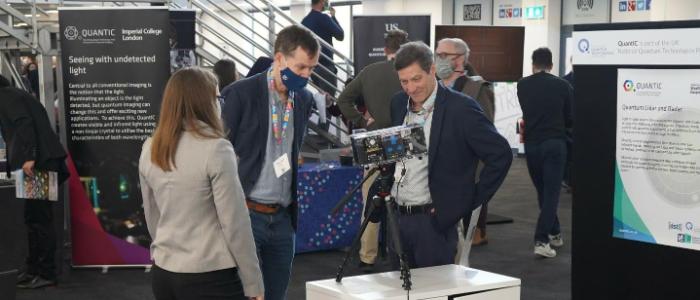Centre for Quantum Technology at the UK Quantum Technology Showcase
Published: 19 November 2021
Find out more
Researchers from the Centre for Quantum Technology joined more than 700 attendees at the UK National Quantum Technology Showcase. Returning for the first time as a face to face event since the COVID-19 pandemic hit, the event highlighted the latest research and innovation delivered by the National Quantum Technology Programme.
The showcase attracted 80 exhibitor and international attendance and demonstrated the success and progress of the UK National Quantum Technologies Programme (UK-NQTP) which is investing £1 billion of private and public funding into quantum research and innovation over the next 10 years.
The Centre for Quantum Technology research was a prominent feature at the event. Prof Miles Padgett exhibited GasSight on the QuantIc stand. Working with M-Squared Lasers Ltd., QuantIC has developed a low-cost imager that can produce real time video of methane gas. Methane is the primary component of natural gas and leaks can be costly, dangerous and contribute to climate change.
GasSight uses a telecoms laser diode to illuminate a scene at 1.65μm, exactly the wavelength corresponding to the absorption of methane gas. This image of the methane cloud is overlaid upon a high resolution RGB image of the overall scene, giving a composite full colour image where the methane appears as a green cloud. The prototype camera has already demonstrated pure methane detection in a laboratory setting at 3m. Our challenge for the next stage will be to increase the sensitivity of the system so that its operational range can be increased to 10 meters or more and be mounted on a drone.

GasSight demonstrator on the QuantIC stand
Another technology developed at the University of Glasgow Centre for Quantum Technology that was centre stage at the exhibition was Wee-g. Supported originally by QuantIC and most recently by the UK Hub for Sensing and Metrology, Wee-g is a new type of gravimeter.
Gravimeters are used for measuring small density variations underground and are highly valuable in fields such as energy, civil engineering, defence and environmental monitoring. Until now, all gravimeters have been both costly and bulky. Glasgow scientists have found a way to adapt a system often found in smartphones to create a cheap and lightweight gravimeter. Wee-g uses the same mass-producible MEMS devices that are used in smartphones’ internal accelerometers to measure gravity.
First published: 19 November 2021

